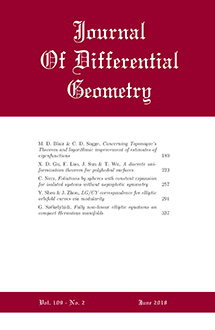Abstract
The Cauchy problem for the homogeneous real/complex Monge–Ampère equation (HRMA/HCMA) arises from the initial value problem for geodesics in the space of Kähler metrics equipped with the Mabuchi metric. This Cauchy problem is believed to be ill-posed and a basic problem is to characterize initial data of (weak) solutions which exist up to time $T$. In this article, we use a quantization method to construct a subsolution of the HCMA on a general projective variety, and we conjecture that it solves the equation for as long as the unique solution exists. The subsolution, called the “quantum analytic continuation potential,” is obtained by (i) Toeplitz quantizing the Hamiltonian flow determined by the Cauchy data, (ii) analytically continuing the quantization, and (iii) taking a certain logarithmic classical limit. We then prove that in the case of torus invariant metrics (where the HCMA reduces to the HRMA) the quantum analytic continuation potential coincides with the well-known Legendre transform potential, and hence solves the equation as long as it is smooth. In the sequel, "The Cauchy problem for the homogeneous Monge–Ampère equation, II. Legendre transform," Adv. Math., 228 (2011), 2989–3025, it is proved that the Legendre transform potential ceases to solve the HCMA once it ceases to be smooth. The results here and in the sequels in particular characterize the initial data of smooth geodesic rays.
Citation
Yanir A. Rubinstein. Steve Zelditch. "The Cauchy problem for the homogeneous Monge-Ampère equation, I. Toeplitz quantization." J. Differential Geom. 90 (2) 303 - 327, February 2012. https://doi.org/10.4310/jdg/1335230849
Information





